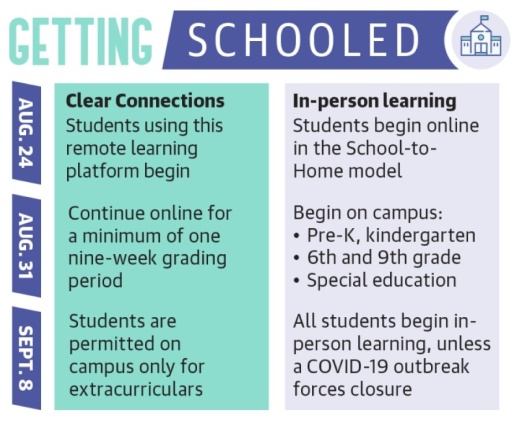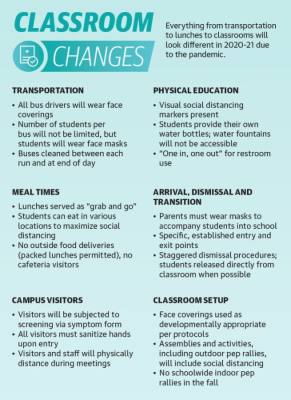The district’s first official day of school is Aug. 24. Brick-and-mortar learners will start using the district’s School-to-Home model, switching to in-person instruction in phases from Aug. 31 to Sept. 8. Families not yet comfortable with brick-and-mortar education can send their children to school online through the district’s new Clear Connections platform. Clear Connections students begin Aug. 24.
District leaders, including Superintendent Greg Smith, have given weekly livestream updates regarding details of the upcoming year since mid-June. Smith said during a July livestream administrators are doing everything possible to provide quality, rigorous, real-time instruction to students from the teachers they love this fall.
“I think overall, we want to provide some level of normalcy to our children, and this is important,” he said during a July 9 livestream. “We need our children back with us, as well as their friends, even if it is 6 feet apart or through a web camera.”
Pandemic spurs safety changes
After collecting community feedback and consulting with public health experts, CCISD will implement new safety policies during the 2020-21 school year.
To date, the district has invested millions into its COVID-19 response. This includes nearly $2.8 in spending to hire new staff, with another $5 spent on additional district-issued laptops to promote effective distance learning.
For in-person instruction, students, staff and visitors will wear face coverings when physical distancing of 6 feet is not possible, as mandated by the Texas Education Agency on July 7. Classroom sizes and student-teacher ratios will remain the same, and the facilities department is maximizing space in each building, Smith said. The school day will be extended by 10 minutes to allow time for students and staff to properly implement health and safety procedures, including putting on masks for arrival, dismissal and transition periods.
An individual facility will not shut down unless suspected or confirmed COVID-19 cases exceed 10% of the building’s occupancy, according to current guidelines. District staff will communicate with parents to identify positive cases. Positive COVID-19 tests among students and staff have been isolated, district Chief Communications Officer Elaina Polsen said in a July 2 email.
Carla Harryman, whose child is going into 11th grade, said she thinks the district is reopening far too soon and plans on having her child attend school virtually. There are not enough ways to get students to practice social distancing, she said, especially in athletic settings.
“My concern is for athletes as well as coaches, and some parents are pushing to return to play,” Harryman wrote. “In a lot of fall sports teams, there is no way to keep the kids 6 feet apart.”
The University Interscholastic League released modifications to its 2020-21 calendar July 21, along with updated COVID-19 risk mitigation guidelines. As a district in Conference 6A, CCISD is required to operate on a delayed sports schedule, along with other 5A and 6A districts in highly populated areas.
Holly Hughes, the CCISD assistant superintendent of elementary education, said during a July 20 board of trustees meeting the beginning of the year will require numerous adjustments, regardless of the start date.
“The first days of any school year take a little ramping up as far as getting the processes and procedures out; that will only be heightened this year,” she said. “That’s going to be a process for us.”
Online learning reformed
Administrators have continually emphasized online learning will not look the same in the fall as it did from March to May, with more real-time components and relationship-building elements incorporated into the 2020-21 school year.
Clear Connections is available for K-12 students; prekindergarten adaptations for in-person education are still being determined. Extracurricular activities will be offered through Clear Connections at students’ homes.
The principal, counselors and lead teachers, all separate from the existing district staff, will work with Clear Connections students. The goal is to give online learners the chance to develop one-on-one relationships with their own teachers, rather than teachers working with both physical and virtual classrooms, Guidance and Counseling Director Dava West said.
A minimum of three online school days per week must include synchronous learning, West said, meaning students will be present in real time. Students who enroll in Clear Connections must stay with this style of learning for a full grading period.
Smith expressed optimism about the opportunity to reimagine remote education.
“Education can occur anywhere, at any time, at any pace, and we’re trying to respond to that,” Smith said July 1, adding as the community adapts, “[this could] really be our finest hour.”
Programming challenges
The district is working to tailor its programming for all types of remote students, including those in need of special services and those looking for further academic enrichment.
Gifted and talented programs will continue online and in person during the 2020-21 academic year, program Executive Director Glenda Holder said. Holder, Polsen and Hughes said during a July 15 livestream they are committed to meeting the unique emotional and intellectual needs of the district’s gifted and talented students, including structuring social time into the school day.
“We assure you that what is right and what we believe gifted and talented students need is at the center of everything that we’re building,” Holder said.
For special education students, the brick-and-mortar model will focus on individualized health plans, but there are more questions than answers when it comes to providing special services through Clear Connections.
The district is researching virtual schools, consulting with other districts and speaking with attorneys about how to provide remote special education, Executive Director of Special Services Michele Staley said during a July 15 livestream. Arrangements will be made to send providers into students’ homes if a service cannot be provided virtually, she said.
Administrators are working with the district’s technology department and the principal of Clear Connections to ensure service providers are up to date with the latest technology to provide services. In the spring, not every provider was well equipped to suddenly adapt with the emergency closure, Polsen and Staley said.
Services must be agreed upon in an Admission, Review and Dismissal meeting. Staley and Polsen acknowledged ARDs can take months to complete; in the event many special education students sign up for Clear Connections, ARDs will be prioritized based on the number and level of services a student needs.
“It’s really important that we get this right for your student and that we partner with you,” said Staley, who started as executive director during the same week the district went into the emergency closure in mid-March. “I’m here to work for you.”







